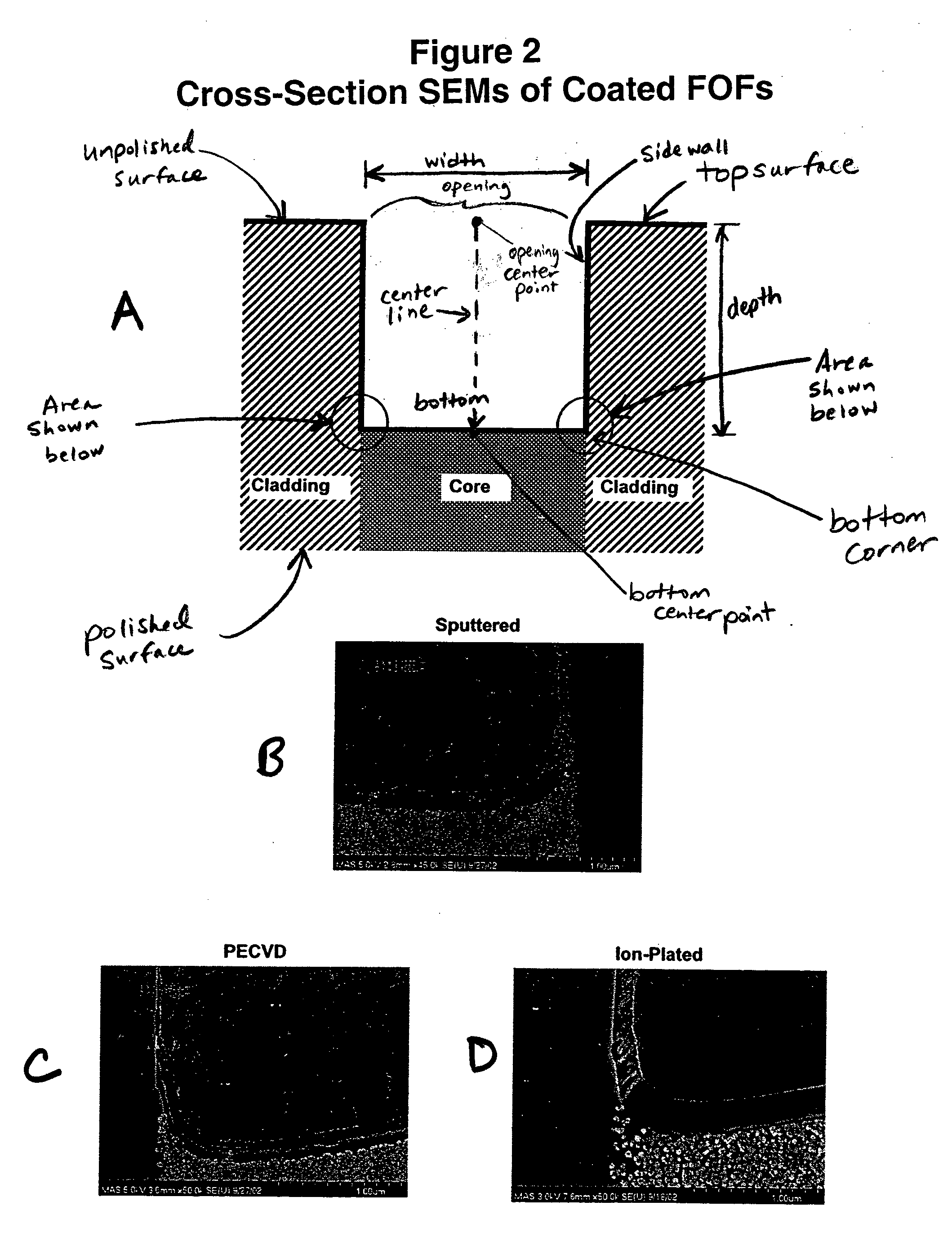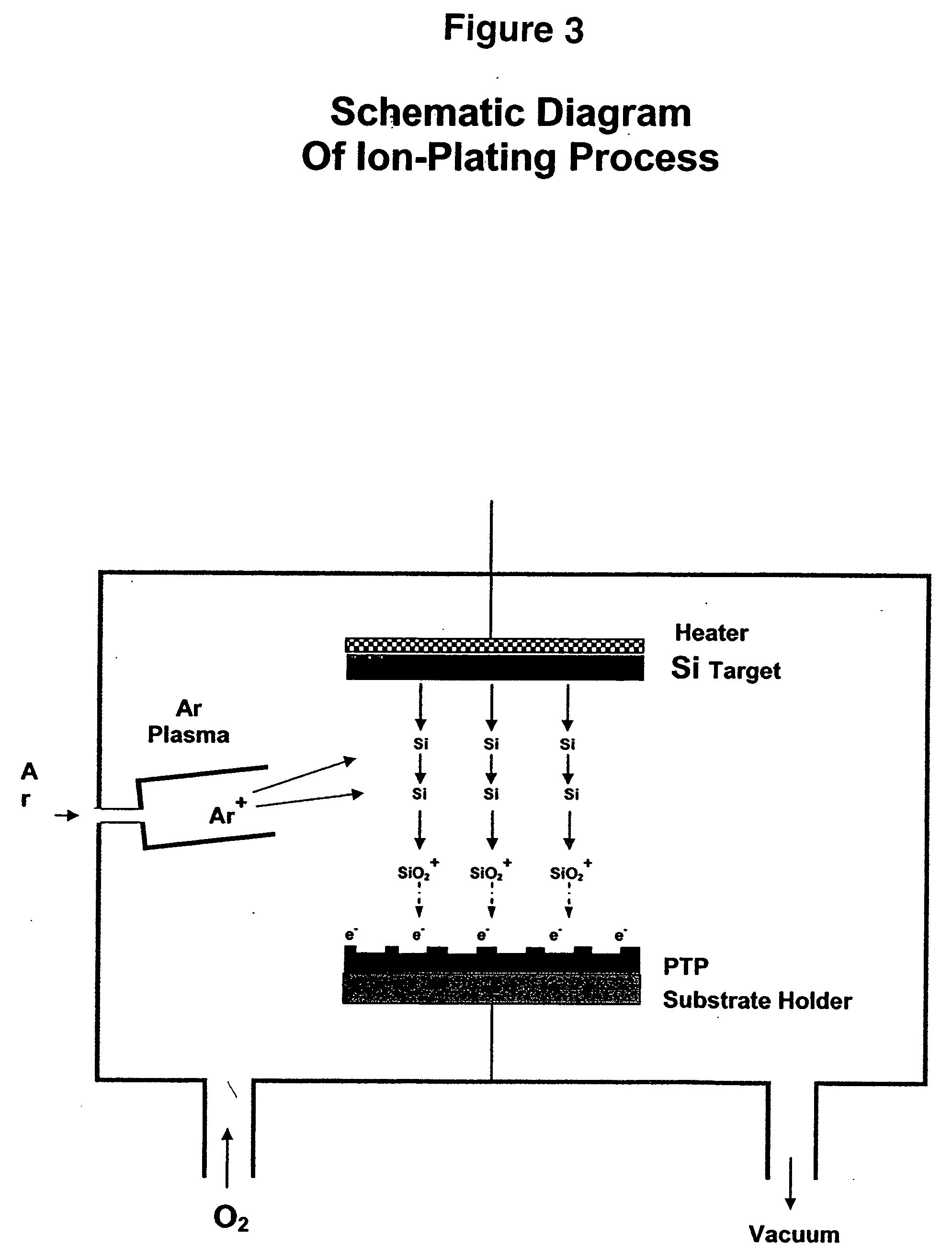Thin film coated microwell arrays and methods of making same
a microwell array and thin film technology, applied in the field of microwell array compositions, can solve the problems of low sensitivity, lack of reproducibility, and high background signal
- Summary
- Abstract
- Description
- Claims
- Application Information
AI Technical Summary
Benefits of technology
Problems solved by technology
Method used
Image
Examples
example 1
General Etching Process and RER Cleaning Procedure
[0255] This example describes the general single-sided etching process for FOFs (Incom Corporation, Charlton, Mass.) sizes 25×75 mm or 40×75 using silicon etch gaskets and PEEK (Poly Ether Ether Ketone) plastic clamps (FIGS. 11a and 11b). Distilled water for the Branson Ultrasonic bath (Fischer Scientific, Hampton, N.H.), from a PicoPure™ water purification unit (“PicoPure water”), was degassed for 10 minutes. The NesLab recirculator (Portsmouth, N.H.) was set to 57.2° C. (at this setting, water inside the ultrasonic bath was maintained at a constant temperature of 55° C.). Four stainless steel containers were covered and placed in the ultrasonic bath. Each container was charged with 1000 mL (for a 25×75 mm FOF) and 1200 mL (for a 40×75 mm FOF) of 20% HNO3 and warmed to 55° C. Ninety-six unetched FOFs were loaded into each of the 96 positions of four etch trays. A designated FOF was selected and weighed. The difference in FOF weight...
example 2
FOF Coating Using Ion-Plating Deposition Method
[0270] FOFs were immediately cleaned prior to thin film coating. The detergent used was Contrad®. The Branson sonicator was set to 40° C. Two FOFs were placed back to back in a Falcon tube, and 40-45 mL of 5% Contrad® solution was added in the tube and the cap closed. The tube was loaded in the sonicator and sonicated for 90 min. FOFs were removed from the tube, rinsed thoroughly with fresh deionized water, and transferred to a new Falcon tube and filled with deionized water. The detergent solution was disposed in the sink and FOFs kept in de-ionized water at 4° C.
[0271] After cleaning, the ion-plating process for coating a chemically etched FOF with a thin film SiO2 coating was performed. The FOF to be coated was placed on an electrically isolated holder in a vacuum chamber, along with an electrically isolated heated silicon target, an argon plasma source, and a source of oxygen. The argon plasma source was ignited, which generated a...
example 3
Exposure of the Transparent Thin Film Coated FOF to “Mock” PCR Conditions
[0272] Transparent thin film coated, etched FOFs were tested for environmental robustness by exposing the etched FOF coated with SiO2 to deionized water at temperatures (approximating PCR thermal exposure), and examining SEM images of both the surfaces and cross-sections for signs of coating damage according to the following procedure. One milliliter of 1×HiFi PCR buffer (Invitrogen, Carlsbad. CA) was prepared. The thin film, etched FOF was placed on top of tissues and using a cell scraper, the excess water was removed. Quickly, 400 μL of the buffer was added on top of the FOF surface and the solution was evenly spread out with a cell scraper. After 1 minute, the excess solution was removed. The procedure of adding 400 μL of the buffer followed by removing the solution was repeated. The FOF was immediately placed in an in-house amplification device (the “AMP jig”) (454 Life Sciences, Branford, Conn.), covered ...
PUM
| Property | Measurement | Unit |
|---|---|---|
| Length | aaaaa | aaaaa |
| Thickness | aaaaa | aaaaa |
| Thickness | aaaaa | aaaaa |
Abstract
Description
Claims
Application Information
 Login to View More
Login to View More - R&D
- Intellectual Property
- Life Sciences
- Materials
- Tech Scout
- Unparalleled Data Quality
- Higher Quality Content
- 60% Fewer Hallucinations
Browse by: Latest US Patents, China's latest patents, Technical Efficacy Thesaurus, Application Domain, Technology Topic, Popular Technical Reports.
© 2025 PatSnap. All rights reserved.Legal|Privacy policy|Modern Slavery Act Transparency Statement|Sitemap|About US| Contact US: help@patsnap.com



